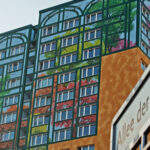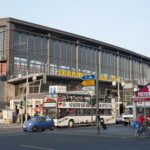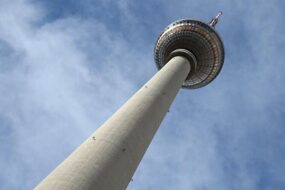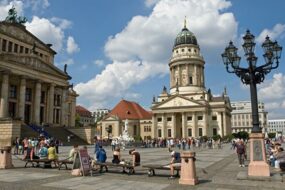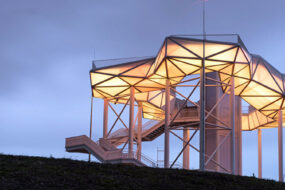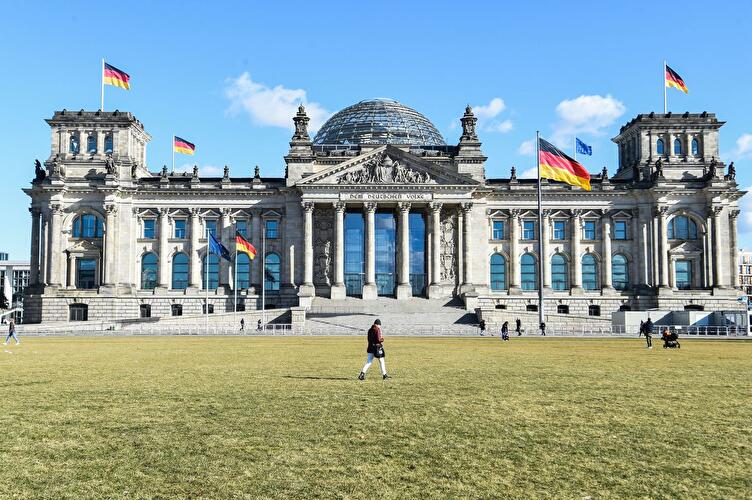
The Reichstag building, with its iconic glass dome, is one of Berlin’s most popular attractions and serves as the seat of the German parliament, the Bundestag.
A Unique Visitor Experience
A visit to the Reichstag offers a firsthand look at where Germany’s political decisions are made. The building’s glass dome and roof terrace provide stunning views of Berlin, making it a must-see destination for visitors. Located along the River Spree, right in the heart of Berlin, the Reichstag’s striking architecture and central location contribute to its appeal. During the warmer months, both Berliners and tourists gather on the vast lawn in front of the building, creating a lively atmosphere.
The Reichstag’s Historical Significance
Constructed between 1884 and 1894 based on designs by architect Paul Wallot, the Reichstag was meant to be a monumental symbol of the newly established German Empire after Berlin became the imperial capital in 1871. Wallot’s design incorporated elements from the Renaissance, Baroque, and Classical architectural styles. The famous inscription “Dem Deutschen Volke” (To the German People) was added in 1916, and still adorns the building today. During World War II, the Reichstag was severely damaged, and its iconic dome had to be demolished. A partial reconstruction began in 1957, but much of the building’s original style was lost during this process.
Seat of the German Bundestag
Since 1990, the Reichstag has housed the German Bundestag, or federal parliament. The first plenary session took place on October 4, 1990, shortly after the reunification of Germany. On June 20, 1991, Berlin was officially selected as the seat of the German government, cementing the Reichstag’s status as the heart of Germany’s political life.
The Glass Dome by Sir Norman Foster
A major renovation in 1994 included the addition of a stunning glass dome, designed by British architect Sir Norman Foster. The structure, made of 800 tons of steel and glass, is 40 meters wide and 23.5 meters high. Inside the dome, two spiral ramps lead visitors up to the observation deck and down to the roof terrace, offering panoramic views of the city. The renovations were completed in 1999, and the Bundestag held its first session in the newly refurbished Reichstag on April 19 of that year.
A Symbol of German History
The Reichstag has been the site of many pivotal moments in German history. On November 9, 1918, Philipp Scheidemann, a member of the SPD, declared the Weimar Republic from a balcony at the west portal. On February 27, 1933, a fire destroyed much of the building, including the plenary chamber and the dome. The Reichstag also played a symbolic role at the end of World War II when Red Army soldiers hoisted the Soviet flag atop the building on April 30, 1945, marking the fall of Nazi Germany.
Christo and Jeanne-Claude’s Art Installation
In the summer of 1995, the Reichstag became an international sensation when artists Christo and Jeanne-Claude wrapped the building in 100,000 square meters of silver fabric. This temporary installation attracted millions of visitors and elevated the Reichstag to global fame.
Visiting the Reichstag Today
The Reichstag is a must-visit for anyone traveling to Berlin. A highlight of the visit is the elevator ride to the rooftop terrace, which offers magnificent views of the Tiergarten and the city. Visitors can also walk through the glass dome and admire the central mirror cylinder, which reflects natural light into the building.
Address:
Platz der Republik 1
10557 Berlin
Opening Hours:
- Daily from 8 AM to midnight (last admission at 10 PM)
Accessibility:
- Barrier-free access via ramps and the West Entrance on Platz der Republik for visitors with disabilities
- Accessible restrooms on each floor
- Induction loops for hearing-impaired visitors during plenary debates and tours
- Tactile models and deep reliefs of the Reichstag for visually impaired visitors
- Braille and audio guides are available for blind visitors
- Sign language video guides are available for deaf visitors in the dome
Admission Fee:
- Free of charge
Important Information:
Visits to the dome and roof terrace require prior registration. You can register online at www.bundestag.de. Information about dome closures can also be found on the Bundestag website.
Public Transportation:
- Train (S-Bahn)
- Underground
- Bus
